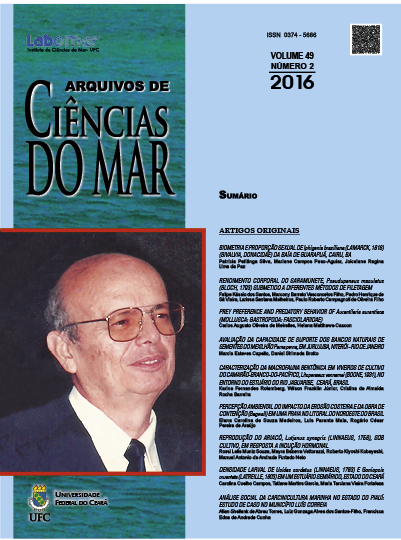Characterization of the benthic macrofauna in farming ponds of whiteleg-shrimp, Litopenaeus vannamei (Boone, 1931), in the vicinity of the Jaguaribe River’s estuary, Ceará, Brazil
DOI:
https://doi.org/10.32360/acmar.v49i2.6580Keywords:
macrofauna, natural food, shrimp farming, Capitella spp.Abstract
This study aimed to characterize the macrofauna within farming ponds of marine shrimp Litopenaeus vannamei and describe the spatial and temporal variations of benthic macroinvertebrates structure in the ponds throughout a growing cycle. Sediment samples were collected with a PVC sampler with 15cm diameter, in the areas of supplying, middle and draining of the ponds with five replicates for each area prior to the settlement and before the shrimp fishing. Polychaetes had the highest average density and Capitella spp. was the most abundant species. The structure of benthic macroinvertebrates has under gone significant changes between the periods prior to stocking of shrimp in the ponds and immediately before shrimp fishing. The decrease in density of benthic macroinvertebrates can be attributed to the predatory pressure of shrimps. The highest density of infaunal organisms in the supply area of ponds may be related to the settlement of larvae near by the entrance of the water in the pond, as well as the greater amount oxygen content in this area.Downloads
Published
2017-05-05
Issue
Section
Artigos originais
License
1. Proposta de Política para Periódicos de Acesso Livre
Autores que publicam nesta revista concordam com os seguintes termos:
- Autores mantém os direitos autorais e concedem à revista o direito de primeira publicação, com o trabalho simultaneamente licenciado sob a Licença Creative Commons Attribution que permite o compartilhamento do trabalho com reconhecimento da autoria e publicação inicial nesta revista.
- Autores têm autorização para assumir contratos adicionais separadamente, para distribuição não-exclusiva da versão do trabalho publicada nesta revista (ex.: publicar em repositório institucional ou como capítulo de livro), com reconhecimento de autoria e publicação inicial nesta revista.
- Autores têm permissão e são estimulados a publicar e distribuir seu trabalho online (ex.: em repositórios institucionais ou na sua página pessoal) a qualquer ponto antes ou durante o processo editorial, já que isso pode gerar alterações produtivas, bem como aumentar o impacto e a citação do trabalho publicado (Veja O Efeito do Acesso Livre).

